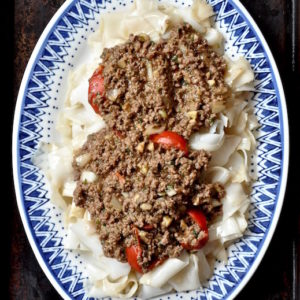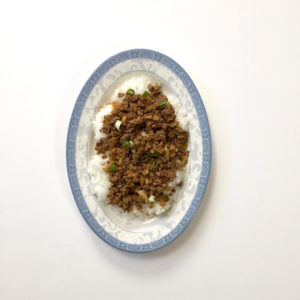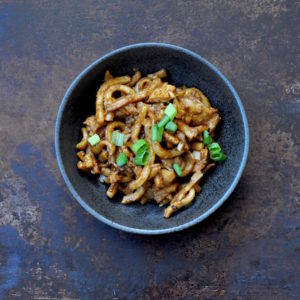(Fake) Thai Drunken Noodles
Why Fake Thai Drunken Noodles?
Well, I’ve never been to Thailand. (And how I long to go.)
And it must be sadly admitted that, much as I passionately love Asian food, I am a Eastern European Jew, through and through.

(In the past two weeks, we’ve had some rain…which led to not one but…)
Possibly most damning is the fact that I’ve never been drunk. And Thai Drunken Noodles, or Pad Kee Mao, are meant to be consumed either while inebriated or soon afterward, ostensibly staving off the negative impacts of excessive drinking.
My lack of drunkeness stems from physical idiosyncrasy. At some point my inner bartender decides it’s last call, dims the lights, and sends me home. I’ve been buzzed. I’ve been silly. But never have I been drunk to the point of stupidity or sickness. Never have I had a hangover.

(two rainbows!)
Finally, of the numerous Thai Drunken Noodle recipes out there, the only one I’ve found to include liquor is Chrissy Teigen’s. Yeah, yeah. Chrissy Teigen is a model who wrote a cookbook. Chrissy Teigen’s recipe for Actual Drunken Noodles put me on the road to these very fine (if I say so myself) fake ones.
Teigen’s cookbook is all right. I mean, a chapter called Thai Mom? We can get behind that.
—
Some details:
After years of thinking I hated oyster sauce for its cloying sweetness, I bought a new jar and achieved wisdom. Which is: Lee Kum Kee Premium Oyster Flavored Sauce is shockingly expensive because “oyster extract” is first on the ingredient list instead of sugar. Pick up the cheaper jar and read that ingredient list. Sugar is the first listed ingredient. Which is exactly what it tastes like.

Noodles: After preparing this dish with udon and fresh rice noodle sheets, I made it with bagged “fresh” Pad-Thai Style rice noodles. Perfection achieved. You need that bit of resistance to stand up to the spicy, aggressive sauce.

Look for Pad Thai-Style rice noodles in the International or Asian foods aisles of better supermarkets. Sometimes you’ll find them in the freezer sections. Or check out your local Asian supermarket, where entire aisles are devoted to bagged noodles and the selection is dizzying.

The spice factor: this dish should be spicy, but heat is a matter of personal taste. I’ve made this dish with homemade Sriracha sauce and the less intense sambal oelek. I love fire. John claims to, but cannot match my passion for hot food. My advice is adjust to your taste and that of your family or guests.

The liquor: Feel free to eliminate this ingredient. I used Japanese Rice Whiskey, which gave the dish a mild flavor profile, rounding the sauce out without adding any harsh peaty notes. (soon I’ll be yammering about notes of pipe smoke and heather.) Avoid harsh or overwhelmingly flavored liquors. They’ll overpower the dish.
Cilantro: A love or loathe herb. If you are in the loathe camp, top your noodles with parsley or leave them nude. Cilantro fans, a few leaves make the dish.
Thai Drunken Noodles are very difficult to stop eating. Leftovers, should there be any, are excellent at any temperature at any time of day. Two people demolished a four-person serving in less than 12 hours.

Fake Thai Drunken Noodles
Inspired by Chrissy Teigen’s Actual Drunken Noodles, from Cravings
Yield: 2-4 servings
For the rice noodles:
1 one-pound bag Pad-Thai style fresh rice noodles (best) or 1 one-pound bag dried fettucine
Peanut or other neutral tasting high-heat refined oil, for the wok
4 ounces homemade or low-sodium chicken or vegetable broth
1 tablespoon oyster sauce
For the marinade:
1 pound boneless pork loin or pork roast, sliced into bite-sized pieces
1 teaspoon sesame oil
For the sauce:
2 tablespoons Golden Mountain Sauce or regular soy sauce (not lite)
1 tablespoon Mirin (unseasoned Japanese rice wine vinegar)
1 tablespoon Japanese rice whiskey, vodka, Vermouth, or non-peated scotch whiskey (optional)
1 tablespoon oyster sauce
1/4 teaspoon-2 tablespoons brown or palm sugar, to taste (see notes)
1/4 teaspoon-1 tablespoon Asian red hot pepper paste of your choice: Sriracha Sauce, sambal oelek, or a bit of crumbled dried Thai red pepper (see notes)
For the stir fry:
Peanut or other neutral refined high-heat oil, for the wok
2 scallions, trimmed and thinly sliced
2-4 garlic cloves, peeled and minced
1 piece ginger, about the size of your index fingernail, peeled, crushed, and minced
1/2 cup unsalted chicken or vegetable broth, if wok goes dry
Optional additions:
4-6 ounces vegetables of your choice, washed and cut into small pieces; blanch hard vegetables in boiling water first to ensure they are cooked through before stir-frying
Cilantro or parsley, for topping the bowls
Additional hot sauce, for the table
You will need a 14-inch wok or large, heavy-bottomed frying pan to make this dish. I prepared the noodles separately, in a 12-inch nonstick wok.
If adding hard vegetables like broccoli, greens, or the fresh bamboo shoot I used, blanch them now and set aside,
Prepare the noodles:
If you are using fettucine, prepare noodles following package instructions. Drain and set aside.
To prepare packaged rice noodles, set a large wok or your largest sturdy frying pan over high heat. Add a generous amount of peanut oil to the pan; noodles like to stick. Once the oil is shimmering, carefully add the noodles. Stir continuously. After a minute or two, noodles will begin softening. Add the oyster sauce. Stir continually for 30 seconds. Add the broth, stirring all the while. Rice noodles do not feel like flour noodles when ready; these will feel rather rigid. Taste if you aren’t sure. They should be pliable within minutes. Take pan off the heat.
Slice the pork into bite-sized pieces, trimming any large chunks of fat. Leaving a little fat is fine. Put pork in a bowl and mix with sesame oil. I find clean hands do this best.
You’ll need the 14-inch wok or large frying pan. If you used it to make the noodles, slide noodles into serving bowls or on a platter, rinse the wok/pan, and place over high heat. Add enough peanut oil to generously coat the bottom. When oil shimmers, add the ginger, garlic, and scallion. Stir-fry a moment or two, until you smell aromas rising. If you are adding hard vegetables, tip them in and cook. Add the pork and stir-fry about one minute.
Add the sauce. If you cooking soft vegetables, add them now. If pan looks dry, pour in a small amount of broth. Don’t swamp the wok, or final dish will be sodden.
Stir fry 3-4 minutes, until pork is cooked through, any vegetables are tender, and everything is ready.
To serve, either arrange noodles on a platter and pour the pork mixture atop it, or serve in individual deep bowls. Top with cilantro or parsley. Bring additional hot pepper sauce to table, if you wish. Leftovers improve the next day.
Notes:
If you avoid pork, this dish works beautifully with boneless chicken breast and thigh; I’ve tried it. It would also work with tofu.
If you are unable to find Pad-Thai style noodles, substitute dried fettucine. Do not use fresh. Prepare according to package instructions.
Golden Mountain Sauce is an all-around Thai seasoning similar to soy sauce. I buy mine at Ranch 99 Market. It is available online. You can use regular soy sauce instead.
I prefer very little sugar in savory dishes and used a tiny corner of a piece of palm sugar. If you want more, taste as you go.
This dish is supposed to be spicy; if you are sensitive to spicy foods or serving this to finicky eaters, start with a 1/2 teaspoon of your preferred paste or pepper and add slowly, tasting as you go. Or use only 1/2 teaspoon in the sauce, and serve more at the table so diners can customize.





